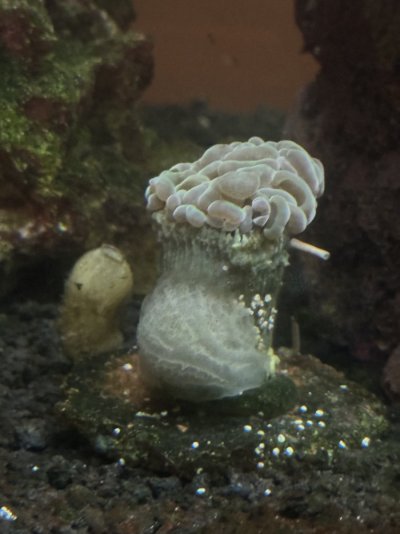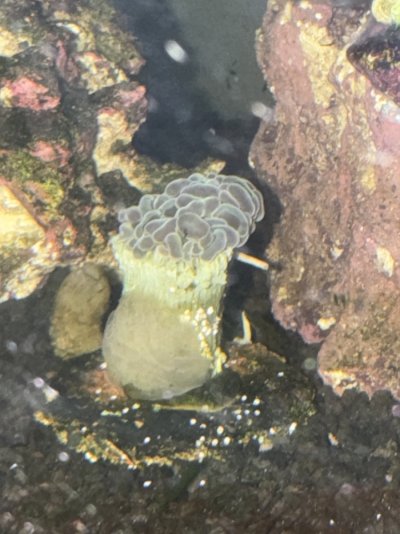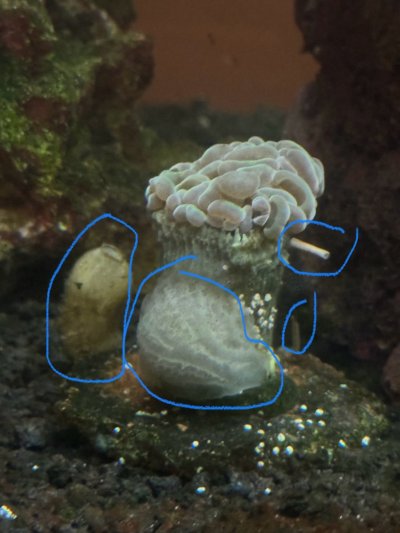Navigation
Install the app
How to install the app on iOS
Follow along with the video below to see how to install our site as a web app on your home screen.
Note: This feature may not be available in some browsers.
More options
You are using an out of date browser. It may not display this or other websites correctly.
You should upgrade or use an alternative browser.
You should upgrade or use an alternative browser.
Growths on hammer
- Thread starter mjreefnewbie
- Start date
- Tagged users None
- Joined
- Dec 8, 2017
- Messages
- 1,271
- Reaction score
- 1,702
So I'm looking again, and you have what looks like the CaribbSea Hawaiian black sand. But then I see what looks like white grains of sand in your black sand bed, which look like the "spots" on the base of your hammer. Are the spots somehow just some white sand grains which some corals can incorporate into their skeletons (though I'm not sure a hammer can even do that?). It looks like sand to me in your pics, and I don't know of any parasite that's white spots on corals (fish, yes, all day long, but not corals), and I know of nothing that infects coral and grows in the sand bad, that makes no sense. Are you sure it's not white sand?
Last edited:
Thanks for your reply, I think you are right that the white dots are grains of sand, however the growths I’m concerned about are the ones circled in this pic. It is kind of hard to tell without them circled so my bad for that. They all appeared within the last week or so and have taken off. All of them are either coming off the skeleton of the hammer or attached to the frag plug. All of them seem to be different types of growth.So I'm looking again, and you have what looks like the CaribbSea Hawaiian black sand. But then I see what looks like white grains of sand in your black sand bed, which look like the "spots" on the base of your hammer. Are the spots somehow just some white sand grains which some corals can incorporate into the skeletons (though I'm not sure a hammer can even d that?). It looks like sand to me in your pics, and I don't know of any parasite that's white spots on corals (fish, yes, all day long, but not corals), and I know of nothing that infects coral and grows in the sand bad, that makes no sense. Are you sure it's not white sand?
Attachments
The two on the left are either sponges or tunicates (I'd guess but I'm not sure that the far left is a solitary tunicate - it should have a second hole/opening visible somewhere if it is - and the second on the left is a sponge).Thanks for your reply, I think you are right that the white dots are grains of sand, however the growths I’m concerned about are the ones circled in this pic. It is kind of hard to tell without them circled so my bad for that. They all appeared within the last week or so and have taken off. All of them are either coming off the skeleton of the hammer or attached to the frag plug. All of them seem to be different types of growth.
For the two on the right, do they move at all? Are they hard or soft? Do you ever see things come out of them?
- Joined
- Dec 8, 2017
- Messages
- 1,271
- Reaction score
- 1,702
I mean, that does look a little strange when I zoom in on it. I am definitely not an expert. I would suggest you post this again under the LPS forum (hammers are in the group LPS corals, just in case you didn't know that). You'll get a lot more replies about this in that forum, I believe.Thanks for your reply, I think you are right that the white dots are grains of sand, however the growths I’m concerned about are the ones circled in this pic. It is kind of hard to tell without them circled so my bad for that. They all appeared within the last week or so and have taken off. All of them are either coming off the skeleton of the hammer or attached to the frag plug. All of them seem to be different types of growth.
https://www.reef2reef.com/forums/general-lps-discussion.44/
As I was replying, @ISpeakForTheSeas to the rescue! This is a reefer who can offer some real help, I'm sure. I'm interested to see what this is as I have a few hammers myself.
The two on the left are either sponges or tunicates (I'd guess but I'm not sure that the far left is a solitary tunicate - it should have a second hole/opening visible somewhere if it is - and the second on the left is a sponge).
For the two on the right, do they move at all? Are they hard or soft? Do you ever see things come out of them?
Awesome, I’ll have to learn about sponges and tunicates. The identification helps a ton.The two on the left are either sponges or tunicates (I'd guess but I'm not sure that the far left is a solitary tunicate - it should have a second hole/opening visible somewhere if it is - and the second on the left is a sponge).
For the two on the right, do they move at all? Are they hard or soft? Do you ever see things come out of them?
The ones on the right are hard and do not move. I have not seen anything come in or out of them.
Solitary tunicates are completely harmless, and the vast majority of sponges are harmless too.Awesome, I’ll have to learn about sponges and tunicates. The identification helps a ton.
The ones on the right are hard and do not move. I have not seen anything come in or out of them.
Some sponges may chemically compete with corals (similar to the chemical warfare - allelopathy - of soft corals), but these are very rare in the hobby. To check, though, how long have you had the hammer, and how long has the sponge been there?
Some sponges are also invasively fast growing - as long as they don't chemically outcompete corals or grow over and smother coral polyps (not the skeletons, but the actual flesh of the corals), they're harmless. (As long as it's not chemically harmful, sponges can grow around corals and on their skeletons just fine - growing over the polyps, however, prevents the coral from getting light and nutrients, so that's when it's harmful). That said, yours doesn't seem to have the typical invasive growth form, so I wouldn't expect many issues that way.
If the tubes are hard and don't move, then they're likely one of three options - vermetid snails (considered pests/sometimes harmful; these should have a spiral to the tube near the base, and they would send out a mucus net that looks like a little web to feed), feather duster worms (these would send out a "feather" crown; harmless filter feeders), or a polychaete worm of some variety like Spionid worms (these would send out two little tentacles called palps; generally harmless unless they're growing out of the coral itself).
Wow thank you so much for the great info.Solitary tunicates are completely harmless, and the vast majority of sponges are harmless too.
Some sponges may chemically compete with corals (similar to the chemical warfare - allelopathy - of soft corals), but these are very rare in the hobby. To check, though, how long have you had the hammer, and how long has the sponge been there?
Some sponges are also invasively fast growing - as long as they don't chemically outcompete corals or grow over and smother coral polyps (not the skeletons, but the actual flesh of the corals), they're harmless. (As long as it's not chemically harmful, sponges can grow around corals and on their skeletons just fine - growing over the polyps, however, prevents the coral from getting light and nutrients, so that's when it's harmful). That said, yours doesn't seem to have the typical invasive growth form, so I wouldn't expect many issues that way.
If the tubes are hard and don't move, then they're likely one of three options - vermetid snails (considered pests/sometimes harmful; these should have a spiral to the tube near the base, and they would send out a mucus net that looks like a little web to feed), feather duster worms (these would send out a "feather" crown; harmless filter feeders), or a polychaete worm of some variety like Spionid worms (these would send out two little tentacles called palps; generally harmless unless they're growing out of the coral itself).
I’ve had the hammer for 7+ months and it has done well the whole time, never closing up until now (been closed up for 2 days) so I jumped to the conclusion the growth on the skeleton was to blame. The sponge has been there for a little over a week. I’ll do some parameter testing tomorrow to check and see if it’s closed for a water quality reason.
I’m pretty certain the tubes haven’t sent out any feather crowns but the mucous net and palps you described are a possibility I could’ve missed. I’ll be on the lookout for those tomorrow as well. The one tube is growing right at the separation line of the skeleton and polyps so would removal of that one be playing it safe ?
If it's been doing well for that long and is suddenly declining, then the growths (specifically the sponge and tubes) may be to blame - checking other possibilities like water quality is a good place to start though.I’ve had the hammer for 7+ months and it has done well the whole time, never closing up until now (been closed up for 2 days) so I jumped to the conclusion the growth on the skeleton was to blame. I’ll do some parameter testing tomorrow to check and see if it’s closed for a water quality reason.
Yeah, removing it would be safe if it's a vermetid or feather duster. It wouldn't do much with Coral-boring Spionids, though, as they bore into the skeleton itself; in small numbers, they're pretty harmless, but they can grow to huge populations sometimes and kill corals off.I’m pretty certain the tubes haven’t sent out any feather crowns but the mucous net and palps you described are a possibility I could’ve missed. I’ll be on the lookout for those tomorrow as well. The one tube is growing right at the separation line of the skeleton and polyps so would removal of that one be playing it safe ?
Similar threads
- Replies
- 7
- Views
- 115
- Replies
- 20
- Views
- 548
- Replies
- 3
- Views
- 106


















